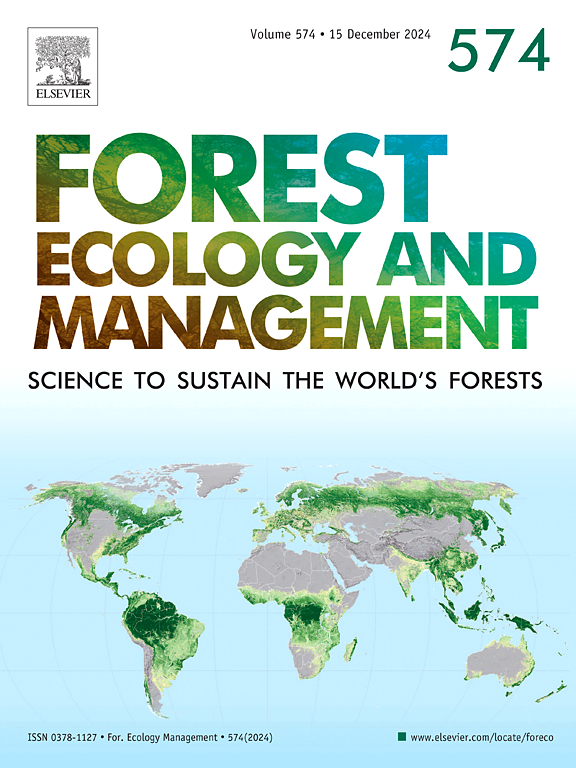热带稀树草原周围的土地利用变化改变了树木的大小结构
IF 3.7
2区 农林科学
Q1 FORESTRY
引用次数: 0
摘要
人为的土地利用变化是目前全球生物多样性面临的最大威胁之一,而热带稀树草原在未来几十年可能会受到这些变化的严重影响。尤其是热带稀树草原大树的消失令人担忧,因为它们具有重要的生态功能。在此,我们研究了非洲南部稀树草原中两种日益占主导地位的土地利用方式--公有土地和集约农业--对被这些改造土地包围的稀树草原中主要大型树种(即旋花木[Senegalia nigrecens]和马鲁拉树[Scelerocarya birrea])的大小等级分布的潜在积极影响(如资源增加、繁殖)和消极影响(如采伐、放牧)。我们共记录了 646 个节栲个体和 303 个马鲁拉个体。这两个物种对周围土地利用类型的反应各不相同。在仅被热带稀树草原包围的稀树草原斑块与被农业区和公社区包围的稀树草原斑块之间,马鲁拉的平均丰度(平均值,± 95 % CI)相似,而大多数大小等级的爵床科植物的丰度则因周围土地的使用而急剧下降,这很可能是由于采伐薪材造成的。在这项研究中,我们发现土地利用变化对大型乔木种群的影响会波及它们周围的热带稀树草原。此外,树木种群的反应取决于周围的土地利用情况和物种特征,这决定了开发活动的性质。不同的开发活动似乎不会影响马鲁拉树的种群数量,但会减少疣刺树的种群数量(如通过采伐木材燃料)。最后,我们提出了一些管理建议,这些建议可能会增加社区地区的疣刺数量。具体来说,我们建议鼓励人们在苗圃中繁殖爵床科植物及其他本地物种和木材燃料物种以供销售,传授促进可持续种群的采伐方法,并鼓励替代燃料来源和多样化的生计。本文章由计算机程序翻译,如有差异,请以英文原文为准。
Land-use changes around remnant savannas alter tree size demographics
Anthropogenic land-use change is currently one of the greatest threats to biodiversity across the globe and tropical savannas are likely to be disproportionately impacted by these changes in coming decades. In particular, the loss of larger savanna trees is concerning because of the critical ecological functions they provide. Here, we studied the potential for positive (e.g., increased resources, propagation) and negative (e.g., harvesting, cattle grazing) influence of two increasingly dominant land uses throughout southern African savannas, communal lands and intensive agricultural, on the size class distributions of dominant large tree species (i.e., knobthorn [Senegalia nigrecens] and marula [Scelerocarya birrea]) in savannas surrounded by these transformed lands. We recorded a total of 646 knobthorn and 303 marula individuals. The two species showed individualistic responses to surrounding land use types. Average abundances (mean, ± 95 % CI) of marula were similar between savanna patches surrounded by savanna only, and savannas surrounded by agricultural and communal areas, while the abundance of most size classes of knobthorn were drastically reduced by surrounding land uses, likely from harvesting for fuel wood. In this study we showed that the influence of land use changes on large tree populations spills over onto the savannas they surround. Furthermore, tree population responses depend on both the surrounding land use and species identity, which determine the nature of exploitative activities. The different exploitative activities appear to be neutral with respect to the populations of marula while reducing populations sizes of knobthorn (i.e. through wood fuel harvesting). We conclude with management recommendations that may increase knobthorn populations in communal areas. Specifically, we suggest encouraging people to propagate knobthorn and other native and wood fuel species for sale at nurseries, teaching harvesting approaches that foster sustainable populations, and encouraging alternative sources fuel and diversified livelihoods.
求助全文
通过发布文献求助,成功后即可免费获取论文全文。
去求助
来源期刊

Forest Ecology and Management
农林科学-林学
CiteScore
7.50
自引率
10.80%
发文量
665
审稿时长
39 days
期刊介绍:
Forest Ecology and Management publishes scientific articles linking forest ecology with forest management, focusing on the application of biological, ecological and social knowledge to the management and conservation of plantations and natural forests. The scope of the journal includes all forest ecosystems of the world.
A peer-review process ensures the quality and international interest of the manuscripts accepted for publication. The journal encourages communication between scientists in disparate fields who share a common interest in ecology and forest management, bridging the gap between research workers and forest managers.
We encourage submission of papers that will have the strongest interest and value to the Journal''s international readership. Some key features of papers with strong interest include:
1. Clear connections between the ecology and management of forests;
2. Novel ideas or approaches to important challenges in forest ecology and management;
3. Studies that address a population of interest beyond the scale of single research sites, Three key points in the design of forest experiments, Forest Ecology and Management 255 (2008) 2022-2023);
4. Review Articles on timely, important topics. Authors are welcome to contact one of the editors to discuss the suitability of a potential review manuscript.
The Journal encourages proposals for special issues examining important areas of forest ecology and management. Potential guest editors should contact any of the Editors to begin discussions about topics, potential papers, and other details.
 求助内容:
求助内容: 应助结果提醒方式:
应助结果提醒方式:


